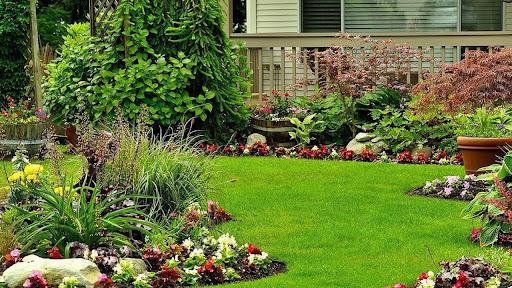Our Blogs

How Can I Create A Low-Maintenance Landscaping Design?
To create a low-maintenance landscaping design, choose drought-tolerant and native plants, use mulch to reduce weeds and retain moisture, incorporate automatic irrigation systems, and select durable, low-maintenance hardscaping materials. Minimize lawn areas and opt for ground covers or gravel to reduce mowing and upkeep.
A well-designed low-maintenance landscape is more than just an aesthetic choice—it's a practical solution for busy homeowners who want to enjoy their outdoor spaces without constant upkeep. At MD Landscape & Design, Thunder Bay’s top-rated landscape company, we understand that a beautiful garden should be easy to care for. With over a decade of experience in landscaping, our team is dedicated to creating outdoor spaces that require minimal maintenance while delivering maximum impact.
Here’s a comprehensive guide to help you design a stunning, hassle-free landscape.
Key Takeaways
Choose native plants for lower maintenance and better adaptation.
Opt for perennials over annuals to reduce replanting.
Minimize lawn areas to decrease mowing and watering needs.
Implement xeriscaping practices to conserve water.
Incorporate hardscaping to limit garden space and enhance functionality.
Use mulch to suppress weeds and retain soil moisture.
Design with plant layering and mass plantings for ease of care.
Select ground covers to replace traditional lawns and reduce maintenance.
Plan for seasonal interest to ensure year-round appeal.
Essential Tips for Creating a Low-Maintenance Landscaping Design
1. Native Plants for Low-Maintenance Landscaping
Native plants are an excellent choice for low-maintenance landscaping because they are perfectly adapted to the local climate and soil conditions. These plants have evolved to thrive in specific environments, meaning they require less water, fertilizer, and pesticides compared to non-native species. This not only makes them eco-friendly but also reduces the time and resources needed for their care. Additionally, native plants support local wildlife by providing habitat and food sources for native insects, birds, and other creatures.
Choosing native species can also enhance the beauty of your garden throughout the year. Plants such as coneflowers, black-eyed Susans, and native grasses are well-suited to various conditions and offer seasonal interest with minimal effort. Incorporating native plants into your garden design ensures a resilient and vibrant landscape that aligns with the natural environment, contributing to a sustainable and easy-to-maintain outdoor space.
Key Benefits:
Adapted to Local Conditions: Requires less water and fertilizer.
Supports Wildlife: Provides habitat and food for local animals.
Low Maintenance: Thrives with minimal intervention.
Seasonal Interest: Offers beauty throughout the year.
2. Perennials vs. Annuals: Which is Better for Your Garden?
When planning a low-maintenance garden, choosing between perennials and annuals is crucial. Perennials are plants that live for several years, coming back each season with minimal effort. This longevity reduces the need for frequent replanting, thereby lowering maintenance and gardening costs. Popular perennials like daylilies, hostas, and lavender provide consistent beauty and structure to your garden, often requiring less attention once established.
In contrast, annuals complete their lifecycle in a single growing season, necessitating replanting every year. While they can offer vibrant, short-term color, the need for annual replanting can increase the time and effort required to maintain your garden. For a low-maintenance approach, perennials are generally the more practical choice, offering long-term value and ongoing appeal.
Key Points:
Longevity: Perennials return annually, reducing replanting efforts.
Cost-Effective: Fewer replacements needed over time.
Consistency: Provides reliable beauty and structure.
Effort: Annuals require more frequent planting and maintenance.
3. Hardscaping Essentials for Low-Maintenance Gardens
Hardscaping involves the use of non-plant materials such as stones, bricks, and concrete to create durable and functional features in your garden. Integrating hardscaping elements into your landscape design can significantly reduce the amount of garden space that requires upkeep. Features like patios, walkways, and retaining walls not only enhance the aesthetic appeal of your outdoor area but also create functional spaces for relaxation and entertainment.
By minimizing the amount of traditional planting space, hardscaping helps lower maintenance needs, as these elements do not require regular watering, weeding, or pruning. Well-designed hardscaping can transform your garden into a stylish and low-maintenance haven, providing a practical solution that complements your overall landscape design.
Advantages:
Durable Materials: Reduces maintenance compared to plants.
Functional Spaces: Creates areas for seating and activities.
Low Upkeep: Requires no watering or weeding.
Aesthetic Appeal: Enhances the visual and functional aspects of your garden.
4. Xeriscaping Techniques for Water Conservation
Xeriscaping is a landscaping approach focused on water conservation, designed to create attractive gardens with minimal water usage. This technique involves grouping plants with similar water needs, selecting drought-resistant species, and using mulch to retain soil moisture. By adopting xeriscaping practices, you can significantly reduce the frequency of watering, making your garden more sustainable and easier to maintain.
The goal of xeriscaping is to create a garden that remains beautiful and functional while using less water. This approach not only conserves a valuable resource but also decreases the amount of time and effort required for garden care. By implementing xeriscaping techniques, you can enjoy a thriving garden with reduced water requirements.
Benefits:
Water Efficiency: Reduces the need for frequent irrigation.
Drought-Resistant Plants: Requires less water and maintenance.
Mulching: Helps retain soil moisture and reduce evaporation.
Sustainable: Conserves water and supports a greener environment.
5. The Benefits of Mulching in Low-Maintenance Gardens
Mulch is an essential component of a low-maintenance garden, offering multiple benefits that simplify garden care. Applying mulch to garden beds helps suppress weeds, which reduces the need for frequent weeding. It also aids in retaining soil moisture, which minimizes the frequency of watering. Additionally, mulch protects plant roots from extreme temperatures, providing a stable environment for plant growth.
Organic mulches, such as wood chips or bark, break down over time, enriching the soil and enhancing its health. This natural process supports plant growth while further reducing maintenance needs. Incorporating mulch into your garden design can significantly decrease the effort required to keep your outdoor space looking its best.
Key Benefits:
Weed Suppression: Reduces the need for manual weeding.
Moisture Retention: Helps keep soil consistently moist.
Temperature Regulation: Protects roots from extreme temperatures.
Soil Enrichment: Organic mulch improves soil quality as it decomposes.
FAQs
1. What are native plants and why are they important for low-maintenance landscaping?
Native plants are species that naturally occur in your region and are adapted to local conditions. They typically require less water, fertilizer, and pesticides, making them ideal for low-maintenance landscaping. They also support local wildlife and enhance biodiversity.
2. How do perennials differ from annuals in terms of maintenance?
Perennials return each year, reducing the need for replanting and saving time and money. Annuals, on the other hand, last only one season and need to be replanted each year, requiring more maintenance.
3. What is xeriscaping and how does it benefit my garden?
Xeriscaping is a water-efficient landscaping method that uses drought-resistant plants and efficient watering practices. It benefits your garden by conserving water, reducing the need for frequent irrigation, and minimizing overall maintenance.
4. How can hardscaping elements reduce garden maintenance?
Hardscaping elements like patios, pathways, and retaining walls replace areas of traditional garden beds, reducing the amount of planting space that requires maintenance. They also create functional areas for relaxation and entertainment.
5. Why is mulch important in a low-maintenance garden?
Mulch helps suppress weeds, retain soil moisture, and protect plant roots. Organic mulch also improves soil quality as it decomposes. This reduces the need for frequent weeding and watering, making it essential for low-maintenance gardens.
Crafting a Beautiful and Effortless Landscape with MD Landscape & Design
Transforming your outdoor space into a low-maintenance paradise is within reach with the right strategies and choices. By focusing on native plants, perennials, hardscaping, and efficient watering practices, you can create a garden that’s not only beautiful but also easy to care for. At MD Landscape & Design, we are committed to helping you achieve a stunning landscape that fits your lifestyle.
Contact us now at MD Landscape & Design to start your journey towards a beautiful and effortless garden. Our experienced team in Thunder Bay is here to bring your vision to life with innovative design solutions and expert care.
Connect with us!

1155 Waterford St, Thunder Bay, ON, CA
info@mdlandscape.ca
Hours:
Monday-Friday from 09:00 AM-5:00 PM
Saturday -Sunday: Closed
COMPANY
INQUIRIES
LANDSCAPING AWARDS



